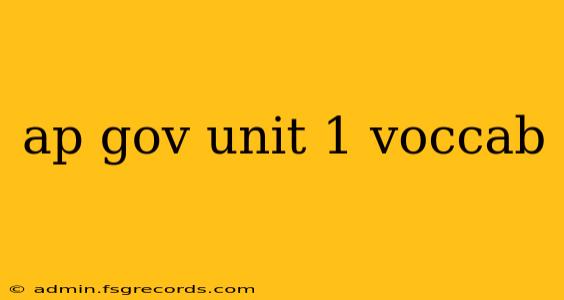Unit 1 of AP Government and Politics lays the groundwork for understanding the intricacies of the American political system. This guide provides definitions and context for key vocabulary terms, helping you master the concepts and ace your exams. We'll go beyond simple definitions, exploring the nuances and practical applications of each term.
Core Principles and Ideologies:
-
Natural Rights: These are rights inherent to all humans, not dependent on government. Think John Locke's concept of life, liberty, and property – influencing the Declaration of Independence. Understanding the philosophical basis of these rights is crucial for analyzing government actions.
-
Social Contract Theory: This theory posits that governments derive their legitimacy from the consent of the governed. Individuals voluntarily surrender certain rights to form a government that protects their remaining rights. Hobbes, Locke, and Rousseau each offered variations on this influential concept. Consider how different interpretations of the social contract have shaped American political thought.
-
Popular Sovereignty: The principle that the authority of a state and its government are created and sustained by the consent of its people, through their elected representatives (rule by the people). This is a cornerstone of American democracy. How does popular sovereignty manifest in the American system? Consider elections, referendums, and initiatives.
-
Republicanism: A system where citizens elect representatives to make decisions on their behalf. This contrasts with direct democracy. Explore the benefits and drawbacks of republicanism – representation versus direct participation.
-
Inalienable Rights: Rights that cannot be surrendered, transferred, or taken away. Often used interchangeably with "natural rights," these are fundamental to the American political system and are often debated in contemporary issues.
-
Consent of the Governed: The idea that a government's legitimacy is derived from the people's agreement to be governed. This is fundamental to the social contract theory and the American system of government. How is this consent expressed? Consider elections, petitions, and protests.
-
Limited Government: A government restricted in its powers, either by a constitution, laws, or widely held beliefs. This is in contrast to a totalitarian government. Explore the mechanisms that limit government power in the US – checks and balances, federalism, and judicial review.
Key Governmental Structures:
-
Federalism: A system of government where power is divided between a central government and smaller, regional governments (states). Understanding the balance of power between the federal government and the states is crucial for analyzing many policy debates.
-
Separation of Powers: The division of governmental powers among different branches (legislative, executive, judicial) to prevent tyranny. This is a key feature of the American system designed to check the power of each branch.
-
Checks and Balances: A system that allows each branch of government to limit the power of the other two branches. Analyze specific examples of checks and balances in action – presidential vetoes, judicial review, and congressional oversight.
-
Confederation: A system of government where independent states unite under a weak central government. Contrast this with a federal system and understand the historical context of the Articles of Confederation.
Further Exploration:
This vocabulary list provides a solid foundation. To truly master Unit 1, actively engage with primary source documents (like the Declaration of Independence and the Constitution), analyze case studies, and practice applying these concepts to current events. Understanding the historical context of these ideas is equally important for a comprehensive understanding. Remember, the AP exam tests your analytical skills as much as your memorization abilities.

